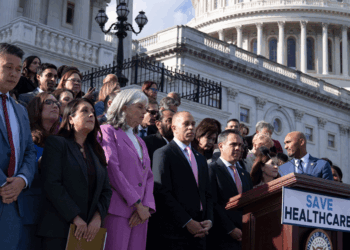Sales of electric vehicles (E.V.s) surged in August and September as buyers took advantage of a federal tax credit before it expired. Now, automakers expect to sell fewer E.V.s—and lose money on them—for the rest of the year.
It raises the question, Is the American E.V. market just a creation of government policy?
“General Motors said it is reducing its electric-vehicle manufacturing capacity and booking a $1.6 billion charge on its EV business as demand sinks,” reports The Wall Street Journal‘s Sharon Terlep. “In a regulatory filing, the company said that EV sales are expected to fall with the end of government-funded subsidies and regulatory mandates that fueled EV growth.”
This was a monumental shift within just a few years: In 2021, General Motors CEO Mary Barra announced the auto giant would phase out all gas-burning vehicles by 2035.
Under the Biden administration, the Environmental Protection Agency (EPA) adopted emissions rules that would effectively require more than half of all new vehicles produced by 2032 to be electric. The agency rescinded those rules in March, after President Donald Trump reentered office.
In September, Congress ended a Biden-era program providing a $7,500 tax credit for purchasing an electric vehicle. Motorists apparently flocked to dealerships ahead of the program’s sunset date, but analysts expected demand to plummet once the credit went away. “The demise of the tax credit will probably bring the party to an end,” Neal E. Boudette wrote last month in The New York Times. “Sales of electric models are expected to plummet in the last three months of the year and then remain sluggish for some time.”
To be clear, slow electric vehicle sales are not General Motors’ only problem, or even the biggest drag on its profits: The tariffs Trump has imposed by fiat are hurting the automaker’s bottom line, as well. As Terlep noted, the $1.6 billion E.V. charge “comes on top of an estimated $4 billion to $5 billion that GM projects it will pay in tariff-related costs this year.” Just in the second quarter of this year, Ford Motor Co. paid $800 million in tariffs and posted its first quarterly financial loss since 2023.
Still, General Motors’ announcement supports the concern that without infusions of taxpayer money, E.V.s are not entirely viable on their own. It’s no wonder, since they have not been driven by consumer preference.
From the start, the Biden-era rules prioritized all-electric vehicles over hybrids, which the EPA estimated would account for only 16 percent of all new vehicles sold by 2032. (For comparison, it estimated there would still be nearly twice that many cars with internal combustion engines.) But consumers have made it clear that if they get rid of their gas-burning cars, they’re more comfortable with a hybrid than an electric.
“While EV sales are growing, their pace is falling well short of the industry’s ambitious timetable for transitioning away from combustion engines,” Tom Krisher of the Associated Press reported in 2023. “Instead, buyers are increasingly embracing a quarter-century-old technology whose popularity has been surging: The gas-electric hybrid, which alternates from gas to battery power to maximize efficiency.”
In its 2024 annual consumer survey, the American Automobile Association (AAA) found similar results: While only 18 percent of respondents said they were likely to buy an electric, 31 percent were open to a hybrid.
“Access to a hybrid vehicle lessens the anxiety for consumers because it allows people to enjoy the benefits of electrification without feeling like they are disrupting their current lifestyle or travel plans (longer distance driving, less charging options, etc.),” AAA noted of its findings.
Even though federal incentives have nudged them in other directions, automakers have tried to follow consumer sentiment. In August 2024, Ford announced it was shifting focus from electrics to hybrids. The automaker had separated its production lines into traditional and electric divisions just two years earlier, and since then, “Ford’s electric vehicle division has lost $12 billion, including $2.2 billion in the first half of this year,” the Times reported in August.
In January 2024, Toyota chairman Akio Toyoda predicted all-electric vehicles would only ever make up about 30 percent of the total automotive market. Instead, Toyoda advocated a “multi-pathway approach” to cutting carbon emissions on the road, and said “customers, not regulations or politics,” should drive innovation.
Toyoda is right. General Motors followed the trend of government rather than consumer sentiment, and now it’s scrambling to adapt when the government changes hands.

















